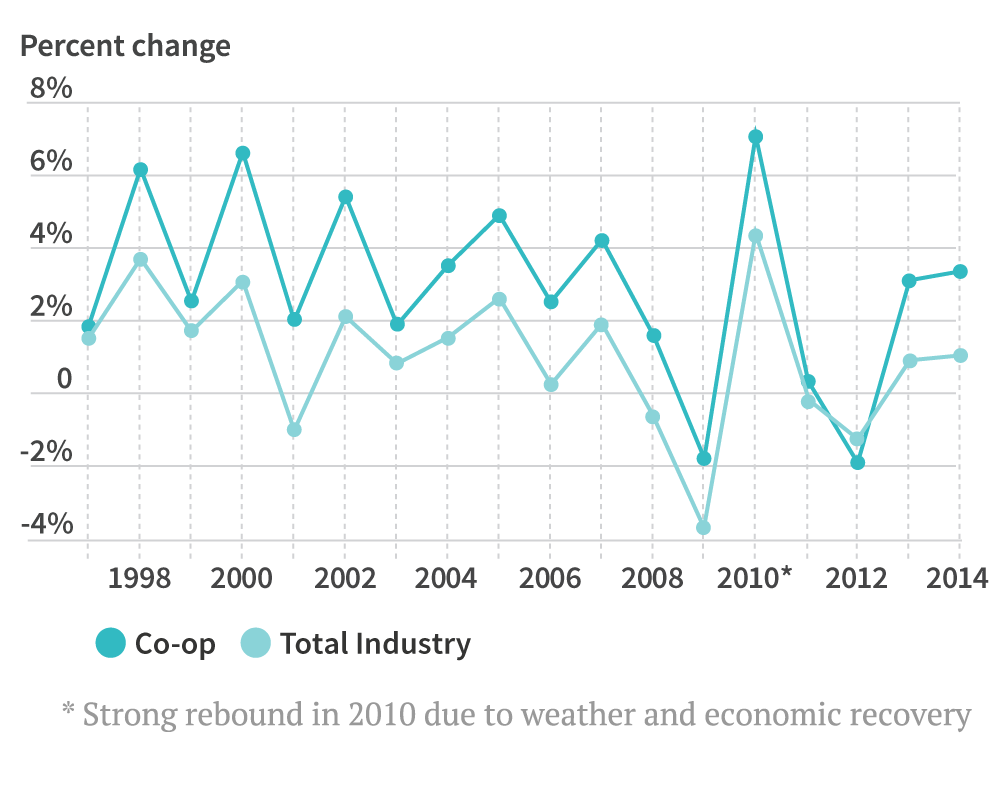The electric cooperative network is 80 years old, but it’s in the middle of a full-fledged growth spurt.
Even though co-ops represent a much smaller part of the electric utility sector than investor-owneds, they’re outperforming the rest of the industry in sales growth and customer growth.
Electric cooperatives saw their retail sales rise 3.3 percent in 2014 to 437 billion kilowatt-hours, according to data prepared by the NRECA Strategic Analysis Unit. That followed up a strong 3 percent increase in 2013.
By comparison, retail sales across the industry increased by just 1.1 percent in 2014 to 3.7 trillion kwh, based on data from the Energy Information Administration. Retail sales in 2013 were even weaker, increasing by just 0.8 percent.
CO-OP SALES GROWTH NORMALLY OUTPACES THE INDUSTRY
“Co-op sales growth rates generally surpass that of the total electric utility industry as a whole. This was especially true in 2013 and 2014 when co-op sales growth outpaced the industry as a whole by wide margins,” the analysis unit said in its annual Vital Signs report, available to registered users of cooperative.com,
Why the boost in a utility segment that represents many poorer, rural parts of the United States? NRECA analysts point to three factors:
Weather: Demand received a strong boost in early 2014 as a polar vortex gripped parts of the country. An arctic blast brought the coldest weather in decades to hundreds of electric cooperative territories, keeping line crews in many areas busy restoring power.
“The amount of damage we have here is equal to Hurricane Hugo,” said David Felkel, president and CEO of Edisto Electric Cooperative in Bamberg, South Carolina, after one storm. Milder weather prevailed throughout the rest of the year, but the early damage sparked co-op sales.
New customers: Co-op Nation welcomed 170,864 new members in 2014. That was an increase of less than 1 percent, and well below the robust 2.8 percent annual average that co-ops enjoyed from 1974 to 2007.
Still, it was above the national average for the industry as a whole, and 84 percent of all co-ops experienced a net increase in customer growth in 2014. Particularly noteworthy: four North Dakota co-ops made the top 10 ranking, based on consumer growth due to oil and gas activity in the Bakken formation.
Nationally, co-op serve about 42 million people.
Economic conditions: The rural economy has struggled to get back to its pre-recession levels, but there are signs that it is picking up in co-op territory. Residential sales grew by 3.2 percent overall but commercial and industrial sales grew even more in 2014—nearly 5 percent, the NRECA Strategic Analysis Unit said.
It also helped that inflation has remained low. For the second year in a row, the overall inflation rose slightly to 1.6 percent, NRECA said, below the Federal Reserve Bank’s target rate of 2 percent.
The result: electricity remains a good value in Co-op Nation. In constant dollars, the average monthly bill in 2014 was about $100, compared with $81 in 2000.
Typical monthly residential electric bills for co-op customers are only up $56 since 2000. “Adjusted for inflation, the total increase has been only $19 or 1.5% per year,” NRECA analysts said. “For a service few could live without, electricity is a real bargain.”
NRECA economists compiled the data from a variety of sources, including filings with the Rural Utilities Service.
Steven Johnson is a staff writer at NRECA.
